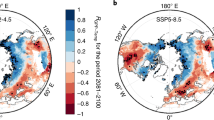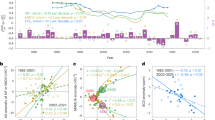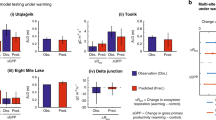Abstract
Climate change is shifting the phenological cycles of plants1, thereby altering the functioning of ecosystems, which in turn induces feedbacks to the climate system2. In northern (north of 30° N) ecosystems, warmer springs lead generally to an earlier onset of the growing season3,4 and increased ecosystem productivity early in the season5. In situ6 and regional7,8,9 studies also provide evidence for lagged effects of spring warmth on plant productivity during the subsequent summer and autumn. However, our current understanding of these lagged effects, including their direction (beneficial or adverse) and geographic distribution, is still very limited. Here we analyse satellite, field-based and modelled data for the period 1982–2011 and show that there are widespread and contrasting lagged productivity responses to spring warmth across northern ecosystems. On the basis of the observational data, we find that roughly 15 per cent of the total study area of about 41 million square kilometres exhibits adverse lagged effects and that roughly 5 per cent of the total study area exhibits beneficial lagged effects. By contrast, current-generation terrestrial carbon-cycle models predict much lower areal fractions of adverse lagged effects (ranging from 1 to 14 per cent) and much higher areal fractions of beneficial lagged effects (ranging from 9 to 54 per cent). We find that elevation and seasonal precipitation patterns largely dictate the geographic pattern and direction of the lagged effects. Inadequate consideration in current models of the effects of the seasonal build-up of water stress on seasonal vegetation growth may therefore be able to explain the differences that we found between our observation-constrained estimates and the model-constrained estimates of lagged effects associated with spring warming. Overall, our results suggest that for many northern ecosystems the benefits of warmer springs on growing-season ecosystem productivity are effectively compensated for by the accumulation of seasonal water deficits, despite the fact that northern ecosystems are thought to be largely temperature- and radiation-limited10.
This is a preview of subscription content, access via your institution
Access options
Access Nature and 54 other Nature Portfolio journals
Get Nature+, our best-value online-access subscription
$29.99 / 30 days
cancel any time
Subscribe to this journal
Receive 51 print issues and online access
$199.00 per year
only $3.90 per issue
Buy this article
- Purchase on Springer Link
- Instant access to full article PDF
Prices may be subject to local taxes which are calculated during checkout



Similar content being viewed by others
Data availability
The satellite NDVI3g data that support the findings of this study were downloaded from http://ecocast.arc.nasa.gov/data/pub/gimms/3g.v0/. The satellite LAI3g data are available from R. B. Myneni (rmyneni@bu.edu) on reasonable request. The LUE-FPAR3g GPP data can be requested from W.K.S. (wksmith@email.arizona.edu) and the FluxNetG GPP data from M. Jung (mjung@bgc-jena.mpg.de). The TRENDYv6 data are available from S.S. (s.a.sitch@exeter.ac.uk) on reasonable request.
References
Fu, Y. H. et al. Declining global warming effects on the phenology of spring leaf unfolding. Nature 526, 104–107 (2015).
Peñuelas, J., Rutishauser, T. & Filella, I. Phenology feedbacks on climate change. Science 324, 887–888 (2009).
Myneni, R., Keeling, C., Tucker, C., Asrar, G. & Nemani, R. R. Increased plant growth in the northern high latitudes from 1981 to 1991. Nature 386, 698–702 (1997).
Menzel, A. et al. European phenological response to climate change matches the warming pattern. Glob. Change Biol. 12, 1969–1976 (2006).
Keenan, T. F. et al. Net carbon uptake has increased through warming-induced changes in temperate forest phenology. Nat. Clim. Change 4, 598–604 (2014).
Richardson, A. D. et al. Climate change, phenology, and phenological control of vegetation feedbacks to the climate system. Agric. For. Meteorol. 169, 156–173 (2013).
Grippa, M. et al. The impact of snow depth and snowmelt on the vegetation variability over central Siberia. Geophys. Res. Lett. 32, L21412 (2005).
Buermann, W., Bikash, P. R., Jung, M., Burn, D. H. & Reichstein, M. Earlier springs decrease peak summer productivity in North American boreal forests. Environ. Res. Lett. 8, 024027 (2013).
Sippel, S. et al. Contrasting and interacting changes in simulated spring and summer carbon cycle extremes in European ecosystems. Environ. Res. Lett. 12, 075006 (2017).
Nemani, R. R. et al. Climate-driven increases in global terrestrial net primary production from 1982 to 1999. Science 300, 1560–1563 (2003).
Settele, J. et al. in Climate Change 2014: Impacts, Adaptation, and Vulnerability. Part A: Global and Sectoral Aspects. Contribution of Working Group II to the Fifth Assessment Report of the IPCC (eds Field, C. B. et al.) 271–359 (Cambridge Univ. Press, Cambridge, 2014).
Forkel, M. et al. Codominant water control on global interannual variability and trends in land surface phenology and greenness. Glob. Change Biol. 21, 3414–3435 (2015).
Piao, S. L. et al. Net carbon dioxide losses of northern ecosystems in response to autumn warming. Nature 451, 49–52 (2008).
Forkel, M. et al. Enhanced seasonal CO2 exchange caused by amplified plant productivity in northern ecosystems. Science 351, 696–699 (2016).
Forzieri, G. et al. Satellites reveal contrasting responses of regional climate to the widespread greening of Earth. Science 356, 1180–1184 (2017).
Richardson, A. D. et al. Influence of spring and autumn phenological transitions on forest ecosystem productivity. Philos. Trans. R. Soc. Lond. B 365, 3227–3246 (2010).
Wolf, S. et al. Warm spring reduced carbon cycle impact of the 2012 US summer drought. Proc. Natl Acad. Sci. USA 113, 5880–5885 (2016).
Keenan, T. & Richardson, A. D. The timing of autumn senescence is affected by the timing of spring phenology: implications for predictive models. Glob. Change Biol. 21, 2634–2641 (2015).
Barnett, T. P., Adam, J. C. & Lettenmaier, D. P. Potential impacts of a warming climate on water availability in snow-dominated regions. Nature 438, 303–309 (2005).
Zhang, K., Kimball, J. S., Kim, Y. & McDonald, K. C. Changing freeze–thaw seasons in northern high latitudes and associated influences on evapotranspiration. Hydrol. Processes 25, 4142–4151 (2011).
Pinzon, J. E. & Tucker, C. J. A. Non-stationary 1981–2012 AVHRR NDVI3g time series. Remote Sens. 6, 6929–6960 (2014).
Sitch, S. et al. Recent trends and drivers of regional sources and sinks of carbon dioxide. Biogeosciences 12, 653–679 (2015).
LeQuéré, C. et al. Global carbon budget 2017. Earth Syst. Sci. Data 10, 405–448 (2018).
Harris, I., Jones, P. D., Osborna, T. J. & Lister, D. H. Updated high-resolution grids of monthly climate observations – the CRU TS3.10 dataset. Int. J. Climatol. 34, 623–642 (2014).
Cadule, P. et al. Benchmarking coupled climate-carbon models against long-term atmospheric CO2 measurements. Glob. Biogeochem. Cycles 24, GB2016 (2010).
Huang, M. et al. Velocity of change in vegetation productivity over northern high latitudes. Nat. Ecol. Evol. 1, 1649–1654 (2017).
Westerling, A. L., Hidalgo, H. G., Cayan, D. R. & Swetnam, T. W. Warming and earlier spring increase western U.S. forest wildfire activity. Science 313, 940–943 (2006).
Sacks, W. J., Schimel, D. S. & Monson, R. K. Coupling between carbon cycling and climate in a high-elevation subalpine forest: a model-data fusion analysis. Oecologia 151, 54–68 (2007).
Parida, B. R. & Buermann, W. Increasing summer drying in North American ecosystems in response to longer nonfrozen periods. Geophys. Res. Lett. 41, 5476–5483 (2014).
Bartholomé, E. & Belward, A. S. GLC2000: a new approach to global land cover mapping from Earth observation data. Int. J. Remote Sens. 26, 1959–1977 (2005).
Zhu, Z. et al. Global data sets of vegetation leaf area index (LAI) 3g and fraction of photosynthetically active radiation (FPAR) 3g derived from global inventory modeling and mapping studies (GIMMS) normalized difference vegetation index (NDVI3g) for the period 1981 to 2011. Remote Sens. 5, 927–948 (2013).
Martens, B. et al. GLEAM v3: satellite-based land evaporation and root-zone soil moisture. Geosci. Model Dev. 10, 1903–1925 (2017).
Jung, M. et al. Global patterns of land-atmosphere fluxes of carbon dioxide, latent heat, and sensible heat derived from eddy covariance, satellite, and meteorological observations. J. Geophys. Res. Biogeosci. 116, G00J07 (2011).
Smith, W. K. et al. Large divergence of satellite and Earth system model estimates of global terrestrial CO2 fertilization. Nat. Clim. Change 6, 306–310 (2016).
Walther, S. et al. Satellite chlorophyll fluorescence measurements reveal large-scale decoupling of photosynthesis and greenness dynamics in boreal evergreen forests. Glob. Change Biol. 22, 2979–2996 (2016).
Wu, C. et al. Land surface phenology derived from normalized difference vegetation index (NDVI) at global FLUXNET sites. Agric. For. Meteorol. 233, 171–182 (2017).
Jiang, C. et al. Inconsistencies of interannual variability and trends in long-term satellite leaf area index products. Glob. Change Biol. 23, 4133–4146 (2017).
Myneni, R. B. et al. The interpretation of spectral vegetation indexes. IEEE Trans. Geosci. Remote Sens. 33, 481–486 (1995).
Acknowledgements
M.O. is funded through an EU Marie Curie Integration grant to W.B. M.F. is funded through the TU Wien Wissenschaftspreis 2015, a personal science award to W. Dorigo. V.H.’s contribution is supported through funding from the Earth Systems and Climate Change Hub of the Australian Government’s National Environmental Science Program. H.T. is supported by the National Key R&D Program of China (2017YFA0604702) and the US National Science Foundation (NSF; 1210360, 1243232). A.D.R. is funded through the Macrosystems Biology Program of the NSF (EF-1702697). This work used eddy covariance data acquired and shared by the FLUXNET community, including the following networks: AmeriFlux, AfriFlux, AsiaFlux, CarboAfrica, CarboEuropeIP, CarboItaly, CarboMont, ChinaFlux, Fluxnet-Canada, GreenGrass, ICOS, KoFlux, LBA, NECC, OzFlux-TERN, TCOS-Siberia and USCCC. The ERA-Interim reanalysis data were provided by ECMWF and processed by LSCE. The FLUXNET eddy covariance data processing and harmonization were carried out by the European Fluxes Database Cluster, AmeriFlux Management Project and Fluxdata project of FLUXNET, with the support of the CDIAC and ICOS Ecosystem Thematic Center, and the OzFlux, ChinaFlux and AsiaFlux offices. We thank M. Jung for providing upscaled FLUXNET GPP data.
Reviewer information
Nature thanks N. Parazoo and the other anonymous reviewer(s) for their contribution to the peer review of this work.
Author information
Authors and Affiliations
Contributions
W.B., M.F. and A.D.R. designed the research. W.B., M.F. and M.O. carried out the analysis and W.B. wrote the manuscript with contributions from all authors. S.S., P.F., V.H., A.K.J., E.K., M.K., S.L., D.L., J.E.M.S.N., H.T., A.J.W. and D.Z. contributed to the TRENDY results. W.K.S. contributed to the LUE-FPAR3g results.
Corresponding author
Ethics declarations
Competing interests
The authors declare no competing interests.
Additional information
Publisher’s note: Springer Nature remains neutral with regard to jurisdictional claims in published maps and institutional affiliations.
Extended data figures and tables
Extended Data Fig. 1 Comparison of lagged productivity responses based on satellite greenness observations and in situ estimates of carbon fluxes across selected FLUXNET sites.
a–c, Site-specific correlations between spring temperature (T) and spring (a), summer (b) or autumn (c) satellite NDVI (x axis) plotted over the corresponding site-specific correlations between spring temperature and spring (a), summer (b) or autumn (c) flux-tower GPP (y axis). In b and c, the relationships are based on partial correlations (pr) between spring temperature and subsequent summer (b) or autumn (c) NDVI or GPP, with covarying effects of summer temperature and precipitation (b) and autumn temperature and precipitation (c) removed. (Partial) correlations are shown for two estimates of GPP: GPP-N (based on night-time partitioning of net ecosystem exchange) and GPP-D (daytime partitioning). d, For this comparison, satellite NDVI time series at 8-km (native) spatial resolution have been extracted for the 16 FluxNet tower sites with at least 10-year data records. Forest types for the tower sites are: ENF, evergeen needleleaf forest; DBF, deciduous broadleaf forest; MF, mixed forest. e, Maps showing the approximate locations of the FLUXNET tower sites. FLUXNET data for this comparative analysis are from the FLUXNET2015 dataset (tier 1).
Extended Data Fig. 2 Random-forest analysis to explain the partial correlation pattern between annual spring temperature and summer satellite greenness on hemispheric and regional scales.
a, Ranked importance of a set of explanatory variables in a random-forest model for the whole northern ecosystem study region, encompassing all vegetated non-agricultural land north of 30° N (see Supplementary Information, section 2, for details on the explanatory variables used). The ranking is based on the highest increment in mean squared error (IncMSE) between the observed and random-forest-predicted correlation after permuting the relevant explanatory variable. b–f, Individual conditional expectation lines of the random-forest-predicted partial correlation (pr) between spring temperature (T) and summer NDVI for the five most important explanatory variables. Lines and shaded bands reflect the mean (regional-average response) and the 5%–95% percentile range (grid-cell-level responses to environmental predictors) for the northern (north of 30° N, non-managed) study region (red) and for the focus regions (Siberia, blue; western USA, green) (see Supplementary Information, section 2).
Extended Data Fig. 3 Spatial pattern of lagged productivity responses based on the individual carbon-cycle models included in TRENDYv6.
All patterns are based on monthly GPP over the period 1982–2011, using outputs from the ten TRENDYv6 models included in the analysis (see Methods). The maps summarize the direction of statistically significant (P < 0.05) correlation between annual spring temperature and spring, summer or autumn GPP. For details on classification scenarios and contour labels, see Fig. 2. Areas with no robust link between spring temperature and spring GPP (dark grey) and areas that are cultivated or managed (light grey) are also shown.
Extended Data Fig. 4 Spatial pattern of lagged productivity and vegetation growth responses estimated through satellite-based and modelling approaches.
a–f, Summary of the direction of robust (P < 0.05) correlations between annual spring temperature and spring, summer or autumn satellite NDVI (a), satellite LAI (b), satellite upscaled GPP (FluxNetG; c), satellite-data-driven LUE-modelled GPP (LUE-FPAR3g; d), and multi-model mean GPP (e) and LAI (f) based on the ten TRENDYv6 models. For details on scenario classifications and contour labels see Fig. 2. Arrows (arrows with strikethroughs) linking panels highlight qualitative agreement (disagreement) between the lagged responses of productivity and vegetation growth based on the various approaches.
Extended Data Fig. 5 Changes in regional climate, satellite greenness and plant carbon fluxes from observation-constrained and modelling approaches for warm- and cold-spring years.
a–f, Monthly anomalies in regionally averaged maximum composited climate (a, d), NDVI (b, e) and GPP (c, f) for warm- and cold-spring years, for the focus regions (a–c, western USA; d–f, Siberia). The anomalies are relative to the mean of the study period (1982–2011) and are based on maximum composites of monthly means of the seven warmest- and coldest-spring years within the study period. The observation-constrained GPP anomalies (c, f) stem from FluxNetG, which combined GPP estimates from flux towers with climate and satellite greenness in a machine-learning framework (see Methods). The boundaries between the climatological seasons are indicated by vertical grey dashed lines. Uncertainty bounds (shaded areas) reflect the spread in the respective monthly anomalies within the compositing period (±1 s.d., n = 7). On the basis of these anomalies, we estimate, for a warm-spring year (relative to mean conditions) in Siberia (area, 2.5 × 106 km2), annual GPP increases of 0.4 Pg C and 1.7 Pg C for FluxNetG and the TRENDYv6 ensemble, respectively, which corresponds to higher plant carbon uptake in the TRENDYv6 ensemble by a factor of roughly four (f). This is, to a large extent (about 64%), because of the overestimation of positive lagged effects in the TRENDYv6 models, but another important factor (36%) is the higher sensitivity of concurrent carbon uptake to spring warming in the TRENDYv6 models (compared to FluxNetG).
Supplementary information
Supplementary Information
This file contains Supplementary Text Sections 1-3, Supplementary Table S1 and Supplementary Figures S1-S7.
Rights and permissions
About this article
Cite this article
Buermann, W., Forkel, M., O’Sullivan, M. et al. Widespread seasonal compensation effects of spring warming on northern plant productivity. Nature 562, 110–114 (2018). https://doi.org/10.1038/s41586-018-0555-7
Received:
Accepted:
Published:
Issue Date:
DOI: https://doi.org/10.1038/s41586-018-0555-7
This article is cited by
-
Earlier spring greening in Northern Hemisphere terrestrial biomes enhanced net ecosystem productivity in summer
Communications Earth & Environment (2024)
-
Reassessment of the risks of climate change for terrestrial ecosystems
Nature Ecology & Evolution (2024)
-
Diminishing carryover benefits of earlier spring vegetation growth
Nature Ecology & Evolution (2024)
-
Transition from positive to negative indirect CO2 effects on the vegetation carbon uptake
Nature Communications (2024)
-
Spring temperature and snow cover co-regulate variations of forest phenology in Changbai Mountains, Northeast China
European Journal of Forest Research (2024)
Comments
By submitting a comment you agree to abide by our Terms and Community Guidelines. If you find something abusive or that does not comply with our terms or guidelines please flag it as inappropriate.



